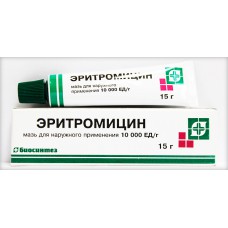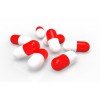Expiration date: 09/2025
Form release
Ointment for external use
Composition
1 g ointment contains erythromycin (based on the active substance) - 10000 IU
Packaging
Tube 15 g.
Pharmacological action
Erythromycin is an antibiotic from the group of macrolides. Acts bacteriostatically. The spectrum of action includes gram-positive (Staphylococcus spp., producing and non-producing penicillinase, Streptococcus pneumoniae, Streptococcus spp., Bacillus anthracis, Clostridium spp., Corinebacterium diphtheriae) and some gram-negative microorganisms (Neisseria gonorrhoeae, Neisseria meningitidis, Bordetella pertussis, Haemophilus influenzae, Brucella spp., Treponema pallidum and Legionella pneumophila).
Resistant to Erythromycin and most of gram-negative bacteria (Escherichia coli, Shigella, Salmonella spp.), mycobacteria, small and medium-sized viruses, fungi.
Erythromycin is transferred to patients better than penicillins, and can be used for allergies to penicillins. Resistance of microorganisms to the drug develops rapidly.
Indications
Infections of the skin and soft tissues (pustular skin diseases, including juvenile acne, infected wounds, bedsores, burns II-III art., trophic ulcers).
Contraindications
Hypersensitivity, jaundice (history), hepatic and/or renal insufficiency, concomitant administration of terfenadine or astemizole.
Method of application and doses
The ointment is applied to the affected skin 2-3 times a day, with burns - 2-3 times a week, the duration of treatment - 1.5-2 months.
Side effect
Possible: impaired liver function, nausea, vomiting, epigastric pain, allergic skin reactions.
Rarely: cholestatic jaundice, anaphylactic shock.
Local reactions: hyperemia, burning, itching, irritation and peeling of the skin, irritation of the mucous membrane of the eye, blurred vision.
Special instruction
Erythromycin can be prescribed if you are allergic to penicillins.
The drug is prescribed with caution in impaired hepatic function and/or kidneys.
Erythromycin is not recommended to drink milk and dairy products.
Erythromycin penetrates the placenta, excreted in breast milk, so the appointment of the drug during pregnancy and lactation should evaluate the intended benefit to the mother and the potential risk to the fetus.
Drug interaction
Erythromycin is incompatible with lincomycin, clindamycin and chloramphenicol due to antagonism of action.
While taking terfenadine or astemizole increases the risk of arrhythmia.
With the simultaneous use of Erythromycin with drugs that block the tubular secretion, the half-life of erythromycin extends.
Erythromycin reduces the bactericidal effect of beta-lactam antibiotics (penicillins, cephalosporins, carbapenems).
With the simultaneous use of Erythromycin with theophylline increases the concentration of the latter.
With simultaneous use of drugs, the metabolism of which is carried out in the liver (carbamazepine, valproic acid, hexobarbital, phenytoin, Alfentanil, dizopiramid, lovastatin, bromocriptine), may increase the concentration of these drugs in plasma, because erythromycin is an inhibitor of microsomal liver enzymes.
Erythromycin increases the nephrotoxicity of cyclosporine (especially in patients with concomitant renal insufficiency).
Erythromycin reduces the clearance of triazolam and midazolam, and therefore can enhance the pharmacological effects of these benzodiazepines.
With simultaneous use of Erythromycin with dihydroergotamine or digidrirovannye ergot alkaloids observed vasoconstriction with the development of spasms of dysesthesia.
Erythromycin slows the removal and enhances the effects of methylprednisolone, felodipine and coumarin anticoagulants.
In a joint appointment with lovastatin may develop rhabdomyolysis.
Erythromycin increases the bioavailability of digoxin and reduces the effectiveness of hormonal contraception.
Storage conditions
In a dry place at room temperature. Keep out of reach of children.



